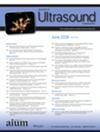The Effect of Backscatter Anisotropy in Assessing Hepatic Steatosis Using Ultrasound Hepatorenal Index
Abstract
Objectives
To discuss challenges in assessing hepatic steatosis using ultrasound hepatorenal index (HRI).
Methods
We retrospectively analyzed HRI and liver magnetic resonance imaging-based proton density fat fraction (MRI-PDFF) in 134 adult participants (53 men and 81 women, mean age 55 years). The diagnostic performance of HRI for determining hepatic steatosis was tested by the area under the receiver operating characteristic curve (AUROC) using liver MRI-PDFF as the reference. Regression plots were employed to compare the sampling sites in liver and kidney that were used to calculate HRIs.
Results
In 11 of 134 cases (8.2%), we failed to acquire HRI measurements. In the remaining 123 cases, AUROC for HRI (cutoff: 1.69 ± 0.13 [mean ± standard deviation]) for defining the HRI threshold for diagnosing hepatic steatosis was 0.83. In 60 of 123 cases (49%) with HRI measurement IQR/median >0.3, slopes of the regression lines in the liver showed backscatter intensity changes consistent with signal attenuation. However, in the kidney, the backscatter intensity was inverted yielding position-dependent HRI cutoff values, mid-pole = 2.24 ± 0.20 and upper pole = 1.08 ± 0.16.
Conclusions
HRI is used to estimate liver steatosis based on backscattered ultrasound. In order to compensate for effects such as body habitus and transducer frequency, the liver backscatter is divided by backscatter from a corresponding region at the same depth in the right renal cortex. Theoretically, this compensation should make HRI sampling position independent. Yet, due to renal cortical backscatter anisotropy, this compensation method does not work in general, potentially producing inaccurate liver fat estimates.

 求助内容:
求助内容: 应助结果提醒方式:
应助结果提醒方式:


